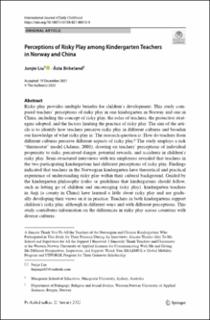| dc.contributor.author | Liu, Junjie | |
| dc.contributor.author | Birkeland, Åsta | |
| dc.date.accessioned | 2022-09-22T10:47:59Z | |
| dc.date.available | 2022-09-22T10:47:59Z | |
| dc.date.created | 2022-01-23T21:37:42Z | |
| dc.date.issued | 2022 | |
| dc.identifier.citation | Liu, J., & Birkeland, Å. (2022). Perceptions of risky play among kindergarten teachers in norway and china. International Journal of Early Childhood. | en_US |
| dc.identifier.issn | 0020-7187 | |
| dc.identifier.uri | https://hdl.handle.net/11250/3020646 | |
| dc.description.abstract | Risky play provides multiple benefits for children’s development. This study compared teachers’ perceptions of risky play in one kindergarten in Norway and one in China, including the concept of risky play, the roles of teachers, the protective strategies adopted, and the factors limiting the practice of risky play. The aim of the article is to identify how teachers perceive risky play in different cultures and broaden our knowledge of what risky play is. The research question is: How do teachers from different cultures perceive different aspects of risky play? The study employs a risk “thermostat” model (Adams, 2001), drawing on teachers’ perceptions of individual propensity to risks, perceived danger, potential rewards, and accidents in children’s risky play. Semi-structured interviews with ten employees revealed that teachers in the two participating kindergartens had different perceptions of risky play. Findings indicated that teachers in the Norwegian kindergarten have theoretical and practical experience of understanding risky play within their cultural background. Guided by the kindergarten philosophy (rules or guidelines that kindergartens should follow, such as letting go of children and encouraging risky play), kindergarten teachers in Anji (a county in China) have learned a little about risky play and are gradually developing their views on it in practice. Teachers in both kindergartens support children’s risky play, although in different ways and with different perceptions. This study contributes information on the differences in risky play across countries with diverse cultures. | en_US |
| dc.language.iso | eng | en_US |
| dc.publisher | Springer | en_US |
| dc.rights | Navngivelse 4.0 Internasjonal | * |
| dc.rights.uri | http://creativecommons.org/licenses/by/4.0/deed.no | * |
| dc.subject | risky play | en_US |
| dc.subject | Norway and China | en_US |
| dc.subject | teachers’ roles | en_US |
| dc.subject | risk and safety | en_US |
| dc.subject | early childhood education | en_US |
| dc.title | Perceptions of Risky Play among Kindergarten Teachers in Norway and China. | en_US |
| dc.type | Peer reviewed | en_US |
| dc.type | Journal article | en_US |
| dc.description.version | publishedVersion | en_US |
| dc.rights.holder | © The Author(s) 2022 | en_US |
| dc.subject.nsi | VDP::Samfunnsvitenskap: 200::Pedagogiske fag: 280 | en_US |
| dc.source.journal | International Journal of Early Childhood | en_US |
| dc.identifier.doi | 10.1007/s13158-021-00313-8 | |
| dc.identifier.cristin | 1988164 | |
| cristin.ispublished | true | |
| cristin.fulltext | original | |
| cristin.qualitycode | 1 | |

